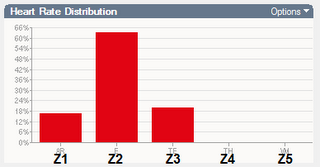More Thoughts on Base Period
I often see comments posted on my blog and receive emails from athletes implying that the Base period should be a time of very low intensity. Some seem to believe that is what I have athletes I coach do. That's really not the case.
This sort of training was called long, slow distance back in the 1970s when it became popular with road runners. It may actually be of some benefit for that sport since running even at very slow speeds is somewhat stressful. If runners were to walk for LSD training they'd be doing something akin to riding a bike or swimming very slowly.
There's not much to be gained for the serious athlete by a winter of noodling along at low effort in zone 1. This sort of low intensity is best for recovery, not for improving fitness. When the effort is down around 50% of VO2max then little is happening to boost cardiovascular or muscular development. The way to do that is to lift the intensity a bit. In recent posts here, here and here I've tried to explain that. But some how the message doesn't seem to be coming across as I expected it would.
As explained in the posts linked above, zone 2 is necessary to boost aerobic endurance. Going very slowly for a long time in zone 1 just won't do it. To improve your speed skills you need to include some very fast-paced swims, bikes or runs for a few seconds at a time with long recoveries. To build force also requires very brief episodes of high effort and long recoveries. And muscular endurance improves with moderate to moderately high intensities such as zones 3 and 4.
So winter is not a time to just cruise along taking in the sights and singing to yourself. Nor is it a time when you should be doing relatively long, high-intensity, anaerobic endurance intervals or fast-paced group workouts that are mini-races. (This assumes, of course, that you have a few months until your first A-priority race of the new season. If you've got an important race in February then high intensity now is the way to go.)
As I told one of my client-athletes yesterday, building fitness is like building a house (my father was a carpenter and sometimes it shows up in how I see the world). The foundation and framework (Base training) must be built carefully and diligently. Everything you do later in the construction depends on this. Training at very hard intensities (zone 5 with lactate/hydrogen accumulation) now is like starting to build the house by doing the finish work first and skipping the foundation and framework. It's not very effective.
So train with some moderate intensity - just don't overdo it. Save the zone 1 stuff for days when you need to recover from harder workouts.
Labels: aerobic endurance, anaerobic endurance, base, intensity, LSD, muscular endurance. force, speed skills


